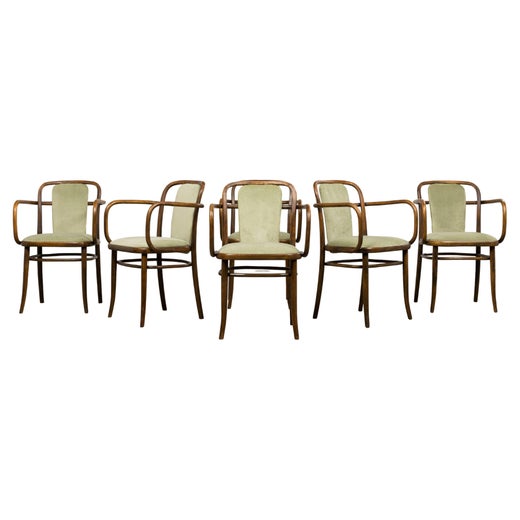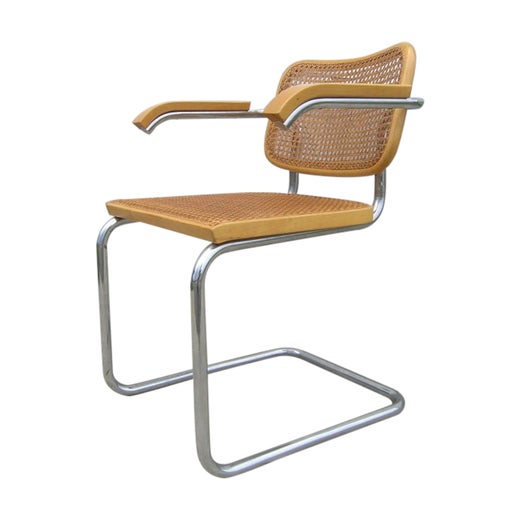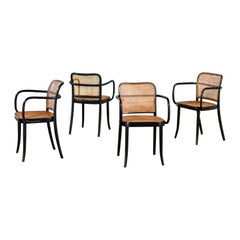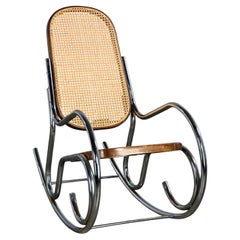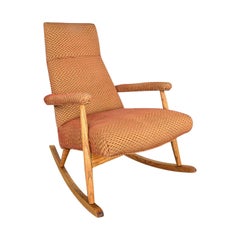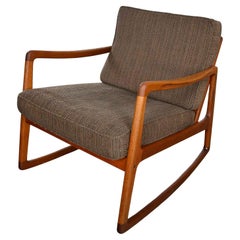Vintage Stendig Bentwood & Cane Rocker Double Circle Design w Handle by Thonet
About the Item
- Creator:Stendig Co. (Retailer),Thonet (Maker)
- Dimensions:Height: 40.25 in (102.24 cm)Width: 20 in (50.8 cm)Depth: 42 in (106.68 cm)Seat Height: 18 in (45.72 cm)
- Style:Bauhaus (In the Style Of)
- Materials and Techniques:
- Place of Origin:
- Period:
- Date of Manufacture:circa 1960s-1970s
- Condition:Wear consistent with age and use. It is in wonderful vintage condition with no outstanding flaws that we have seen. Please see photos.
- Seller Location:Topeka, KS
- Reference Number:Seller: 414-SEA-1961stDibs: LU1873314032892
Thonet
For more than 180 years, Thonet — or Gebrüder Thonet — has produced elegant and durable tables and cabinets as well as chairs, stools and other seating that wholly blur the lines between art and design. Widely known as a trailblazer in the use of bentwood in furniture, the European manufacturer has reimagined the places in which we gather.
Noted for his skill in parquetry, German-Austrian company founder Michael Thonet received an invitation from Austrian Chancellor Prince Metternich to contribute Neo-Rococo interiors to the Liechtenstein City Palace in Vienna. The Boppard-born Thonet had honed his carpentry skills in his father’s workshop, where he carried out experiments with plywood and modified the Biedermeier chairs that populated the studio.
Thonet’s work for the chancellor raised his profile, and the cabinetmaker gained international recognition, including at London’s Great Exhibition of 1851, which featured works created by members of the Arts and Crafts movement as well as industrial products of the day. Thonet showed a range of furniture at the fair and won the bronze medal for his bentwood chairs. He incorporated his family’s company, the Thonet Brothers, with his sons in 1853.
Bentwood furniture dates as far back as the Middle Ages, but it is the 19th-century cabinetmaker Thonet who is most often associated with this now-classic technique. Thonet in 1856 patented a method for bending solid wood through the use of steam, and from there, the bentwood look skyrocketed to furniture fame. The works of renowned mid-century modern designers such as Alvar Aalto, Arne Jacobsen, and Charles and Ray Eames that put this technological advancement to use would not be as extensive or celebrated were it not for the efforts of the pioneering Thonet.
Considered the world’s oldest mass-produced chair, Michael Thonet’s ubiquitous Chair No. 14 demonstrated that his patented bentwood technology made it possible to efficiently produce furniture on an industrial scale. Now known as the 214, it won the German Sustainability Award Design for 2021, a recognition of the company’s commitment to environmentally responsible production.
Often called the Coffee House chair — the company’s first substantial order was for a Viennese coffeehouse — the No. 14 remains an icon. Thonet originally designed the chair in 1859, and it is considered the starting point for modern furniture.
The bentwood process opened doors — there were investments in machinery and new industrial processes, and the business began mass-producing furniture. By the end of the 1850s, there were additional Thonet workshops in Eastern Europe and hundreds of employees. Michael Thonet’s reputation attracted the attention of notable architects including Otto Wagner, Marcel Breuer and Ludwig Mies van der Rohe.
The No. 14 was followed by the No. 18, or the Bistro chair, in 1867, and the 209, or the Architect’s chair, of which Le Corbusier was a fan. (The influential Swiss-French architect and designer used Thonet furniture in his Pavillon de l’Esprit Nouveau at the 1925 International Exposition of Decorative Arts in Paris.)
Thonet’s chair designs also appeared in artwork by Toulouse-Lautrec, John Sloan and Henri Matisse in his Interior with a Violin Case. The noteworthy Thonet rocking chair remains a marvel of construction — in the middle of the 19th century, Michael produced a series of rockers in which the different curved parts were integrated into fluid, sinuous wholes. Thanks to Thonet, the humble rocker acquired something unexpected: style. It was captured in the paintings of Pablo Picasso, Pierre-Auguste Renoir and James Tissot.
Thonet is currently split into global divisions. Thonet Industries U.S.A. was acquired in 1987 by Shelby Williams and joined the CF Group in 1999, while the Thonet brand in Germany is owned by Thonet GmbH.
Find a collection of antique Thonet furniture on 1stDibs.
Stendig Co.
Stendig Co. played a pivotal role in introducing modern European furniture to the American market, thanks to the business acumen of founder Charles Stendig.
Around 1950, the Brooklyn, New York–born Stendig (1924–2024) worked for Raymor, a purveyor of modern china and accessories that is best known for distributing designer Russel Wright’s American Modern line of ceramics. While at Raymor, Stendig focused on the company’s less popular pieces that were made in Italy and Scandinavia, recognizing their potential for the American market. In 1955, he left the company and decided to establish Stendig Co.
That year, a chance encounter with a Finnish trade representative led him to furniture company Asko — one of the largest companies operating in Scandinavia. Asko invited him and Joseph Carreiro, a professor at the Philadelphia College of Art (now the University of the Arts), to help refine their designs.
At Asko’s production facility in Finland, Stendig met several renowned Finnish designers such as Ilmari Tapiovaara, Tapio Wirkkala and Eero Aarnio, the iconic Ball chair creator. Stendig’s trip there was a success, and Stendig Co. began importing Finnish furniture to the United States.
In 1956, the first Stendig Co. showroom opened in Manhattan. A year later, during a trip to Zurich, Stendig came across a Bauhaus–inspired furniture store featuring pieces by Swiss designers Kurt Thut, Hans Eichenberger and Robert Haussmann, the store’s co-owner. Following a meeting with Haussmann, Stendig became the retailer’s exclusive U.S. distributor.
Throughout the late 1950s and early 1960s, Stendig Co. imported and sold furniture from influential European designers, including Swiss designer Bruno Rey, Italian architect and industrial designer Vico Magistretti and Hungarian-American architect and designer Marcel Breuer, creator of the Wassily lounge chair.
By the late 1960s, Stendig Co. moved its headquarters to an expansive space on Manhattan’s East Side and opened showrooms in Los Angeles, San Francisco and Chicago, each home to the company’s striking collection of mid-century European armchairs, sofas, dining room chairs, coffee tables and other furnishings. Stendig’s founder was by then representing Italian manufacturers Poltronova and Gufram and bringing revolutionary works of Italian Radical design to American shores.
In 1971, Charles Stendig sold the company to Burlington Industries. He retired in 1976. Today Stendig’s European imports are coveted by interior designers and vintage furniture collectors, and he will be forever known as the man who introduced modern European design to the United States.
Find a range of vintage Stendig Co. furniture on 1stDibs.
You May Also Like
Mid-20th Century Victorian Rocking Chairs
Cane, Bentwood
Mid-20th Century Unknown Mid-Century Modern Rocking Chairs
Velvet, Cane, Bentwood
Early 20th Century Unknown Art Nouveau Rocking Chairs
Oak
Mid-20th Century Mid-Century Modern Rocking Chairs
Cane, Bentwood
Antique Early 1900s European Vienna Secession Rocking Chairs
Cane, Bentwood
Vintage 1970s American Mid-Century Modern Rocking Chairs
Cane, Bentwood
Mid-20th Century Victorian Rocking Chairs
Bamboo, Cane, Bentwood
Mid-20th Century Rocking Chairs
Cane, Bentwood
Vintage 1960s Polish Mid-Century Modern Rocking Chairs
Cane, Bentwood
Vintage 1940s Austrian Art Deco Rocking Chairs
Rattan, Beech, Bentwood
More From This Seller
View AllEarly 20th Century Czech Bauhaus Armchairs
Cane, Bentwood, Paint
Mid-20th Century Unknown Bauhaus Rocking Chairs
Chrome
Mid-20th Century Mid-Century Modern Rocking Chairs
Fabric, Oak
Mid-20th Century Danish Scandinavian Modern Rocking Chairs
Fabric, Teak
Late 20th Century Modern Settees
Fabric, Oak, Bentwood
Late 20th Century Italian Bauhaus Side Chairs
Chrome
